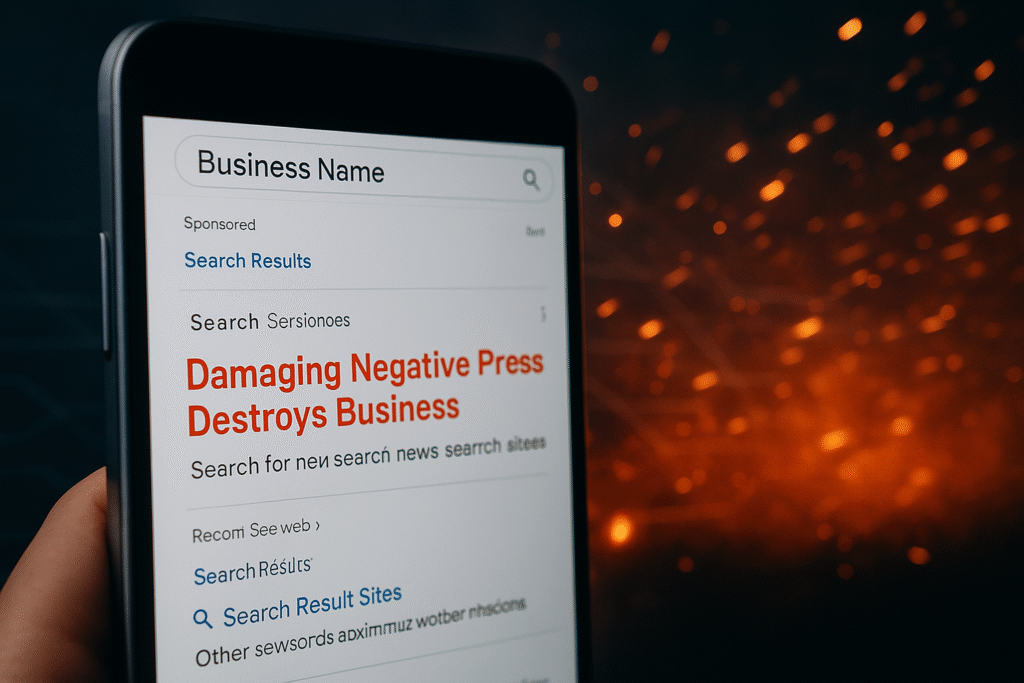How One Negative Article Can Bury Your Business
It takes years to build a great reputation. Years of early mornings, late nights, excellent customer service, and community involvement. It’s your most valuable asset.
And it can be torched online in about ten minutes.
It’s a scenario I’ve seen play out with gut-wrenching regularity over my decade in marketing. A small business owner wakes up one morning to a Google Alert with their name on it. It links to a negative blog post from an angry customer, a misleading local news story, or a scathing review on a complaint site. Their first thought is usually, “This is unfair. People will see the truth. I’ll just ignore it.”
That is the single most dangerous assumption you can make in the digital age.
Ignoring a negative article online is like ignoring a small wildfire on a windy day. You might think it will burn itself out, but the reality is that it’s about to spread. And fast. In the digital world, that wind is social media and Google’s own algorithm, and they can turn a small spark into an inferno that consumes your online reputation.
How serious is this? The data is stark. An often-cited statistic from research by Moz, a leading SEO authority, suggests that businesses risk losing 22% of their customers when just one negative article is found on the first page of their search results. If three negative articles pop up? That number jumps to a staggering 59.2%.
This isn’t a “what if” scenario. This is a clear and present danger to your bottom line. In this guide, we’re going to pull back the curtain on how this digital wildfire spreads, calculate the real cost of doing nothing, and give you a 3-step defense plan to protect the business you’ve worked so hard to build.

The Anatomy of a Digital Wildfire: How Negativity Spreads So Fast
To fight back, you first need to understand the enemy. A negative article doesn’t just sit there. It gets amplified by a powerful digital ecosystem that is, unfortunately, biased toward outrage and negativity. Here’s how it happens.
Step 1: The Spark (The Initial Article)
It all starts with a single piece of content. This could be:
- A blog post from a disgruntled customer or ex-employee.
- A one-sided story from a local news outlet.
- A detailed complaint on a high-ranking consumer advocacy site.
The source doesn’t even have to be well-known. It just has to exist. This is the spark that falls on the dry grass.
Step 2: The Wind (Social Media & Outrage Algorithms)
The spark is instantly fanned by the wind of social media. An angry person shares the article on Facebook, Twitter, or a local community group. Here’s the problem: social media algorithms are designed to promote engagement, and nothing engages people like outrage.
Negative content gets more comments, more shares, and more angry-face emojis than positive content. The platforms’ algorithms see this activity and think, “Wow, this is popular!” They then show it to more people, creating a vicious cycle. Within hours, a story can be seen by thousands in your local community.
Step 3: The Kindling (Other Websites & Backlinks)
As the story spreads on social media, other websites start to pick it up. News aggregator sites, industry bloggers, and other content creators might link back to the original negative article.
In the eyes of Google, these links are “votes of confidence.” When a high-authority site (like a news outlet) links to the negative article, it tells Google, “Hey, this piece of content is important and credible!” This is the kindling that allows the fire to grow from a small brush fire into a raging forest fire.
Step 4: The Takeover (Dominating Your Search Results)
This is the final, devastating step. Now, when a potential customer Googles your business name, they don’t just see your website. They see the negative article, now supercharged with social media buzz and backlinks, sitting right there on the first page.
Why does it often outrank your own website? Because the news site or complaint blog it’s on often has a higher “Domain Authority”—think of it as more “Google Trust”—than your small business website does.
And this is the moment the damage becomes permanent. An explosive study on Google’s click-through rates from Backlinko found that less than 1% of Google searchers ever click on something on the second page. If that negative article is on page one, it will be seen. It becomes a permanent part of your digital reputation. The fire has taken over.
The High Cost of Doing Nothing: Quantifying the Damage
Okay, so it’s a problem. But how much does it really cost you? As a business owner, you need to see the numbers. Let’s calculate the tangible cost of that “digital wildfire.”
We already know that a single negative article can deter about 22% of potential customers. Let’s turn that into a simple formula for your business.
Your “Cost of Inaction” Formula:
- Estimate Monthly Leads from Search: How many new customers or leads do you think find you through Google each month? Let’s say it’s 50.
- Calculate Lost Leads: Multiply that by the 22% deterrent rate.
- 50 leads x 0.22 = 11 lost leads per month
- Determine Your Average Customer Value: What is the average lifetime value of a new customer to your business? Let’s say it’s $500.
- Calculate Monthly Revenue Lost: Multiply the lost leads by your customer value.
- 11 lost leads x $500/customer = **$5,500 in lost revenue. Every. Single. Month.**
That’s $66,000 in lost revenue over a year from one single negative article that you chose to ignore. And this doesn’t even account for the other “hidden” costs:
- Hiring Challenges: The best candidates for a job always Google the company first. A negative story can scare away top talent.
- Lower Employee Morale: Nobody wants to work for a company that’s being publicly trashed.
- Damaged Partnerships: Potential business partners or investors will do their due diligence. A reputation crisis can make them think twice.
The cost of doing nothing is not zero. It’s a massive, ongoing drain on your business.
You Can’t Always Delete, But You Can Displace: Your 3-Step Defense Plan
So what can you do? Panicking or getting into a public shouting match is like pouring gasoline on the fire. You need a calm, strategic, professional response. The goal isn’t always to delete the negative article (which can be difficult or impossible), but to displace it. You need to bury it with a flood of positive, authoritative content that you control.
This is your 3-step defense plan.
Step 1: Rapid Response (Fire Containment)
The moment you discover the negative content, the clock starts ticking.
- Assess, Don’t React: Read the article carefully. Is it a legitimate customer complaint, a factual error, or a malicious attack? Your response depends on the source.
- Never Get in a Public Fight: Do not leave an angry comment on the blog or social media. This only adds fuel to the fire, creates more negative engagement, and makes you look unprofessional.
- Consider a Professional, One-Time Response: If the complaint is on a platform where you can reply (like Yelp or a news article with comments), a single, calm, professional response can be effective. Something like: “We are very sorry to hear about this experience. This does not reflect our standards. We have reached out directly to address this.” This shows other readers that you are accountable.
- Check for Terms of Service Violations: Does the article contain hate speech, threats, or provably false and defamatory statements? If so, you can report it to the platform it’s hosted on. Removal is rare, but it’s the first step to check.
Step 2: The “Content Flood” (Building a Firebreak)
This is where you go on the offensive. You need to create a “firebreak” of positive content that will eventually push the negative article down to the second page of Google—the digital graveyard. This is an aggressive SEO and content marketing strategy.
- Publish Optimized Blog Posts: Start publishing high-quality, helpful content on your own website’s blog. Write about topics your customers are searching for.
- Create Video Content: Video ranks incredibly well and is a powerful signal of authenticity. A short series of “how-to” videos or expert tips can quickly start to rank for your business name.
- Issue a Press Release: Have you won an award, hired a new key employee, or sponsored a local charity event? A professionally written and distributed press release can often rank on the first page of Google very quickly.
- Claim and Optimize All Social Profiles: Create and fully optimize profiles on every major social media platform (LinkedIn, Facebook, Instagram, X, YouTube, etc.). These profiles often rank on the first page for your brand name.
The goal is to create a portfolio of positive, authoritative web properties that you control, leaving no room for the negative article on page one.
Step 3: Fortify Your Digital Assets (Long-Term Prevention)
Once you’ve started the content flood, you need to build a long-term “digital fortress” to protect your reputation from future attacks.
- Implement a Proactive Review Strategy: A steady stream of positive reviews on Google is one of the most powerful trust signals you can have. You need a system to consistently ask your happy customers for feedback.
- Monitor Your Brand Name: Set up Google Alerts and other brand monitoring tools to get instantly notified if your business name is mentioned online. Early detection is key.
- Build Your Authority: Continue to seek out opportunities for positive PR, guest posts on other websites, and features in local media.
How Business Solutions Marketing Group Becomes Your Digital Fire Department
Reading through that 3-step plan, you probably had the same thought I did: “That sounds like a full-time job.”
It is.
Effectively managing a reputation crisis and building a proactive defense is a complex, time-consuming, and highly skilled process. It’s not something you can do in your spare time. That is exactly why our Reputation Management programs exist.
Think of our team at Business Solutions Marketing Group as your digital fire department. When a crisis hits, you call us.
- We bring the strategy and the cool heads. We know not to panic. We know exactly how to assess the situation and build the right defense plan.
- We bring the heavy equipment. We have the content writers, SEO experts, and video production capabilities to create the “content flood” needed to bury negative results.
- We build the firebreaks. Our programs, like our Review Builder, are designed to be your long-term defense, creating the fortress of positive content and reviews that protects you from future attacks.
You’ve spent years building your business. Don’t let a single negative article tear it down.
Key Takeaways
- Negativity Spreads Fast: A single negative article is amplified by social media and other websites, allowing it to quickly dominate your Google search results.
- The Cost of Inaction is Huge: A negative result on page one can cost you over 20% of your potential customers, leading to tens of thousands of dollars in lost revenue per year.
- Page One is All That Matters: With less than 1% of users ever clicking to the second page of Google, a negative result on page one is a permanent stain on your reputation if left unchecked.
- The Strategy is to Displace, Not Just Delete: The most effective defense is a “content flood”—an aggressive SEO strategy to create and rank a portfolio of positive content that you control, pushing the negative result off the first page.
- You Need a Proactive Defense: Building a “digital fortress” through consistent content creation and proactive review generation is the best way to protect your business from future attacks.
Common Questions About Online Reputation Management
- Can’t I just sue the person to have the article taken down? While that can feel like the most satisfying option, it’s often not the best first step. Defamation lawsuits can be incredibly expensive, time-consuming (often taking years), and difficult to win, as you have to prove the statements are factually false and were made with malicious intent. Furthermore, a public lawsuit can sometimes bring even more attention to the negative content (this is known as the Streisand Effect). It’s an option we can discuss, but an aggressive SEO-based suppression campaign is often faster and more effective.
- How long does it take to push a negative result off the first page of Google? There’s no magic wand. The timeline depends on the authority of the negative site and the intensity of our counter-campaign. For a negative post on a low-quality blog, we might see results in a few months. For a story from a major news outlet, it can be a much longer and more sustained effort, often taking six months to a year or more of consistent work.
- What’s the difference between this “reputation management” and regular SEO? Think of it this way: Regular SEO is about ranking your website for your services (e.g., “plumber near me”). Reputation Management SEO is about controlling the entire first page of search results for your brand name. The tactics overlap, but the goal is different. Reputation management focuses on creating and ranking a whole portfolio of web properties (your website, social profiles, videos, press releases) to ensure you dominate the conversation about your brand.
- Will the negative article ever truly go away? It might not. The goal of a suppression campaign is not necessarily to delete the article from the internet, but to push it so far down in the search results that it becomes irrelevant. Since almost no one clicks past the first page of Google, a result on page two or three receives virtually no traffic and has almost no impact on your business.
- What is the very first thing I should do if I discover a negative article about my business? First, take a deep breath and do not react emotionally online. Do not engage in a public argument. Second, take screenshots and save the URL of the article and any related social media posts. Third, and most importantly, contact a professional reputation management firm like ours. The sooner we can assess the situation and start building a counter-strategy, the faster we can contain the damage.
GBP LInk – https://g.co/kgs/GR8yH4a
LinkedIn – https://www.linkedin.com/company/business-solutions-marketing-group-llc/?viewAsMember=true
Instagram – https://www.instagram.com/business_solutions_mg/
Twitter – https://x.com/BSMGLLC
Facebook – https://www.facebook.com/BusinessSolutionsMarketingGroup
BlueSky: https://bsky.app/profile/bussolutions.bsky.social
TikTok – https://www.tiktok.com/@linda_donnelly
YouTube – https://www.youtube.com/channel/UC4w357-txvxOaHff2hTfSSg






